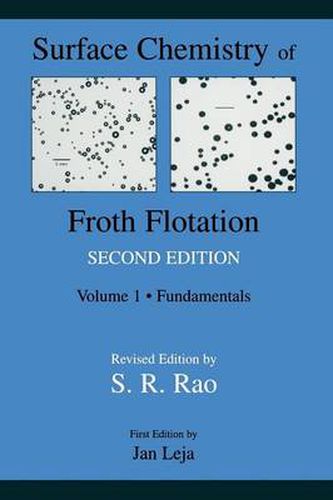Readings Newsletter
Become a Readings Member to make your shopping experience even easier.
Sign in or sign up for free!
You’re not far away from qualifying for FREE standard shipping within Australia
You’ve qualified for FREE standard shipping within Australia
The cart is loading…






This title is printed to order. This book may have been self-published. If so, we cannot guarantee the quality of the content. In the main most books will have gone through the editing process however some may not. We therefore suggest that you be aware of this before ordering this book. If in doubt check either the author or publisher’s details as we are unable to accept any returns unless they are faulty. Please contact us if you have any questions.
th The technology of froth flotation, invented in the early 20 century was first used for the concentration of sulfide minerals. Since then it has been applied for the processing of many nonsulfide ores as weIl, including oxides, carbonates, silicates, soluble minerals like halite and sylvite and energy minerals like coal and bitumen. In recent years it has been used for several nonrnineral applications, such as waste water treatment, deinking of paper for recycling and resource recovery from industrial wastes he technology continues to grow with new applications reported every year. Flotation is based on chemical phenomena occurring at the interfaces, solid/water and air/water. Surface Chemistry principles have played a significant role in the development of flotation technology. Knowledge of aqueous solution chemistry and electrochemistry has added to our understanding of the reactions in flotation systems. Professor Jan Leja’s book has weIl served researchers and students as they tried to understand the chemistry of flotation, and it is a significant contribution to the advancement of knowledge. However, since the book was first published, new research techniques and ever growing information have made an update necessary. The revised edition compiled by Dr. S. R. Rao has brought together fundamental aspects of the chemistry of flotation and how they apply to practical systems. It should serve all who are working in the area of flotation and interested in exploring new applications of flotation technology.
$9.00 standard shipping within Australia
FREE standard shipping within Australia for orders over $100.00
Express & International shipping calculated at checkout
This title is printed to order. This book may have been self-published. If so, we cannot guarantee the quality of the content. In the main most books will have gone through the editing process however some may not. We therefore suggest that you be aware of this before ordering this book. If in doubt check either the author or publisher’s details as we are unable to accept any returns unless they are faulty. Please contact us if you have any questions.
th The technology of froth flotation, invented in the early 20 century was first used for the concentration of sulfide minerals. Since then it has been applied for the processing of many nonsulfide ores as weIl, including oxides, carbonates, silicates, soluble minerals like halite and sylvite and energy minerals like coal and bitumen. In recent years it has been used for several nonrnineral applications, such as waste water treatment, deinking of paper for recycling and resource recovery from industrial wastes he technology continues to grow with new applications reported every year. Flotation is based on chemical phenomena occurring at the interfaces, solid/water and air/water. Surface Chemistry principles have played a significant role in the development of flotation technology. Knowledge of aqueous solution chemistry and electrochemistry has added to our understanding of the reactions in flotation systems. Professor Jan Leja’s book has weIl served researchers and students as they tried to understand the chemistry of flotation, and it is a significant contribution to the advancement of knowledge. However, since the book was first published, new research techniques and ever growing information have made an update necessary. The revised edition compiled by Dr. S. R. Rao has brought together fundamental aspects of the chemistry of flotation and how they apply to practical systems. It should serve all who are working in the area of flotation and interested in exploring new applications of flotation technology.